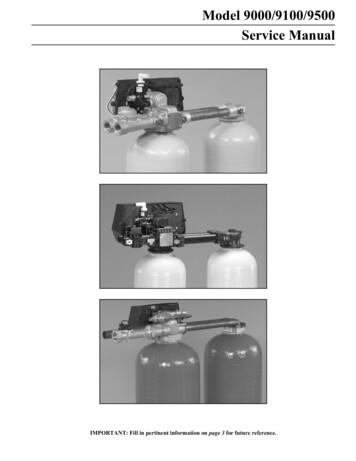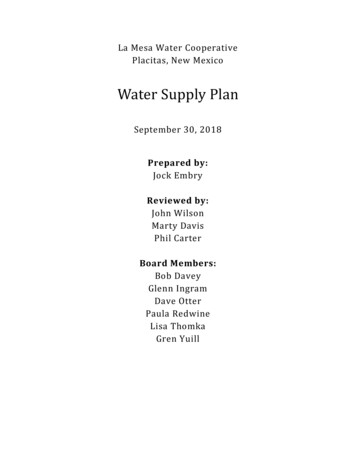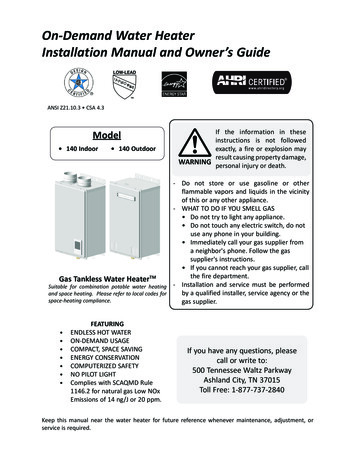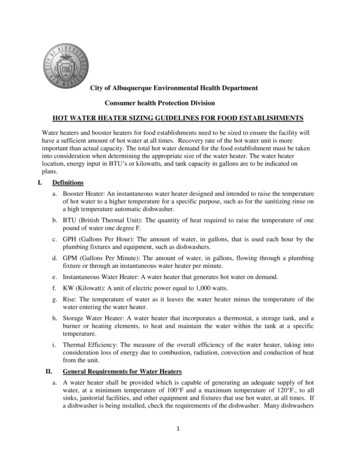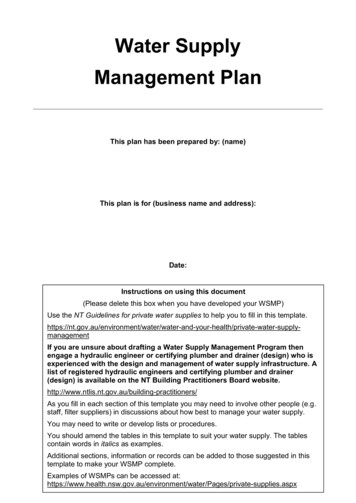
Transcription
June 24, 2021Version 1.1Developing a Water ManagementProgram to Reduce LegionellaGrowth & Spread in BuildingsA PRACTICAL GUIDE TO IMPLEMENTINGINDUSTRY STANDARDS
Foreword3.5Legionnaires’ Disease Is On the Rise2000 00Your building may need a watermanagement program to reduce the riskfor Legionnaires’ disease associated withyour building water system and devices.This water management program shouldidentify areas or devices in your buildingwhere Legionella might grow or spread topeople so that you can reduce that risk.Legionella water management programsare now an industry standard for largebuildings in the United States (ASHRAE188: Legionellosis: Risk Management forBuilding Water Systems June 26, 2015.ASHRAE: Atlanta).Incidence (cases/100,000 pop.)Legionnaires’ disease is a serious type of pneumonia caused by bacteria, called Legionella, that livein water. Legionella can make people sick when they inhale contaminated water from building watersystems that are not adequately maintained. Unfortunately, Legionnaires’ disease is on the rise in theUnited States. To reverse this trend, we are asking for your help to manage the risk of exposure toLegionella from water in your building.Year*National Notifiable Disease Surveillance SystemThis toolkit will help you develop andIn the United States, reported cases of Legionnaires’ disease haveimplement a water management programincreased by nearly four and a half times since 2000. More illnessto reduce your building’s risk for growingoccurs in the summer and early fall but can happen any time of year.and spreading Legionella. If you alreadyhave a program, this toolkit will help you assess and strengthen it. Included are practical resources tohelp you ensure that your water management program is comprehensive, effective, and in line withindustry standards. This toolkit also highlights special considerations for healthcare facilities.Because building water systems vary in their design and complexity, examples in this toolkit are onlymeant to help you understand the process. You should develop a water management program to reduceLegionella growth and spread that is specific to your building.We welcome your feedback on this toolkit by emailing RDB@cdc.gov.For additional information about Legionnaires’ disease, visit www.cdc.gov/legionella.This toolkit can also be found online at www.cdc.gov/legionella/WMPtoolkit.Nancy Messonnier, MD, CAPT USPHSDirector, National Center for Immunization andRespiratory DiseasesU.S. Centers for Disease Control and PreventioniiPatrick Breysse, PhDDirector, National Center for EnvironmentalHealth/Agency for Toxic Substances andDisease RegistryU.S. Centers for Disease Control and Prevention
Table of ContentsForeword . . . . . . . . . . . . . . . . . . . . . . . . . . . . . . . . . . . . . . . . . . . . . . . . . . . . . . . . . . . . . . . . . . . . . iiHow to Use This Toolkit . . . . . . . . . . . . . . . . . . . . . . . . . . . . . . . . . . . . . . . . . . . . . . . . . . . . . . . . . 1Identifying Buildings at Increased Risk . . . . . . . . . . . . . . . . . . . . . . . . . . . . . . . . . . . . . . . . . . . . . 2Glossary . . . . . . . . . . . . . . . . . . . . . . . . . . . . . . . . . . . . . . . . . . . . . . . . . . . . . . . . . . . . . . . . . . . . . 3Introduction to Legionella Ecology . . . . . . . . . . . . . . . . . . . . . . . . . . . . . . . . . . . . . . . . . . . . . . . . 4Elements of a Water Management Program . . . . . . . . . . . . . . . . . . . . . . . . . . . . . . . . . . . . . . . . . 6Establish a Water Management Program Team . . . . . . . . . . . . . . . . . . . . . . . . . . . . . . . . . . . . . . . 7Describe Your Building Water Systems Using Text . . . . . . . . . . . . . . . . . . . . . . . . . . . . . . . . . . . . 8Describe Your Building Water Systems Using a Flow Diagram . . . . . . . . . . . . . . . . . . . . . . . . . . 10Identify Areas Where Legionella Could Grow & Spread . . . . . . . . . . . . . . . . . . . . . . . . . . . . . . . 11Control Measures & Corrective Actions: The Basics . . . . . . . . . . . . . . . . . . . . . . . . . . . . . . . . . . 12Decide Where Control Measures Should Be Applied . . . . . . . . . . . . . . . . . . . . . . . . . . . . . . . . . 13Decide How to Monitor Your Control Measures . . . . . . . . . . . . . . . . . . . . . . . . . . . . . . . . . . . . . 14Establish Ways to Intervene When Control Limits Are Not Met . . . . . . . . . . . . . . . . . . . . . . . . . 15Corrective Action Examples . . . . . . . . . . . . . . . . . . . . . . . . . . . . . . . . . . . . . . . . . . . . . . . . . . . . 15Contingency Response Examples . . . . . . . . . . . . . . . . . . . . . . . . . . . . . . . . . . . . . . . . . . . . . . . 18Make Sure the Program Is Running as Designed & Is Effective . . . . . . . . . . . . . . . . . . . . . . . . . 21Document & Communicate All the Activities of Your Water Management Program . . . . . . . . . . 22Special Considerations for Healthcare Facilities . . . . . . . . . . . . . . . . . . . . . . . . . . . . . . . . . . . . . 23Elements of a Water Management Program . . . . . . . . . . . . . . . . . . . . . . . . . . . . . . . . . . . . . . . . 23Identifying & Investigating Legionnaires’ Disease Cases . . . . . . . . . . . . . . . . . . . . . . . . . . . . . . . 24References & Resources . . . . . . . . . . . . . . . . . . . . . . . . . . . . . . . . . . . . . . . . . . . . . . . . . . . . . . . 26Appendix A . . . . . . . . . . . . . . . . . . . . . . . . . . . . . . . . . . . . . . . . . . . . . . . . . . . . . . . . . . . . . . . . . . 29Appendix B . . . . . . . . . . . . . . . . . . . . . . . . . . . . . . . . . . . . . . . . . . . . . . . . . . . . . . . . . . . . . . . . . . 30iii
How to Use This ToolkitIf you’ve never developed a Legionella watermanagement program (a plan to reduce the risk ofLegionella growth and spread), you might not besure where or how to start. This toolkit will provideguidance to help you develop, implement, andevaluate a Legionella water management programfor your building. You do not have to have trainingor certification in any specific hazard analysis, riskassessment, or risk management methodologiesto use this toolkit. However, you may need toseek help from an expert in some cases. Be sureto follow all relevant federal, state, and local laws,regulations, and ordinances. If anything in thistoolkit conflicts with these policies, always adhereto the policies.Where do we start?The first step is to determine if you even need aprogram. You can use the worksheet on page 2to find out if your entire building or parts of it are atincreased risk for Legionella growth and spread.If you learn that you need to develop a program,this toolkit will explain what steps you should takeand give several examples to clarify the process.Do we really need a watermanagement program to preventLegionella growth and spread?If you answer YES to any of the questions onpage 2, then yes! Developing and implementinga program means that you are helping to protectpeople from getting Legionnaires’ disease, aserious type of pneumonia (see Appendix A formore information on this disease).Is this toolkit full of scientific terms?You might come across some technical terms thatare unfamiliar. The glossary on page 3 and theintroduction to Legionella ecology on pages 4–5should help you with these terms.Will this toolkit tell us everythingthat we need to do?No. Because every building is unique, only youhave access to all the information that is neededto develop and implement a program specificto your building. An example of a building isincluded to help illustrate some of the steps. It’simportant to know that these examples are notcomprehensive and you will need to create aprogram specific to your building water systemand devices.This toolkit looks really long.What’s the bottom line?You need to actively identify and managehazardous conditions that support growth andspread of Legionella. As you work through thetoolkit, you’ll learn about the importance ofidentifying and controlling hazardous conditionsthat increase the chance of Legionella growth andspread. The bottom line is that you need to: Identify building water systems for whichLegionella control measures are neededAssess how much risk the hazardousconditions in those water systems poseApply control measures to reduce thehazardous conditions, whenever possible, toprevent Legionella growth and spreadMake sure the program is running asdesigned and is effectiveIs there anyone who can help usdevelop our program?Yes. As you’ll learn in the toolkit, it’srecommended that you form a watermanagement team. Your team should include avariety of people who bring different skills to thetable (learn more on page 7). You might alreadyhave all the expertise you need on staff, butsometimes you will need to get outside help. Insome cases, you may need to train your in-housepersonnel or hire professionals with specificexperience in Legionella bacteria in building watersystems, such as a certified industrial hygienist,a microbiologist, or an environmental healthspecialist. Blueprints could come in handy, too.What do all of the gray boxes mean?The gray boxes throughout the documenthighlight program elements that are especiallyrelevant for healthcare facilities. The content foundoutside of the gray boxes is also applicable tothese types of facilities.Reference: ASHRAE 188: Legionellosis: Risk Management for Building Water Systems June 26, 2015. ASHRAE: Atlanta. www.ashrae.org1
DEVELOPING A LEGIONELLA WATER MANAGEMENT PROGRAMIdentifying Buildings at Increased RiskSurvey your building (or property) to determine if you need a water management program to reduce therisk of Legionella growth and spread.If you answer YES to any of questions 1 through 4, you should have a water managementprogram for that building’s hot and cold water distribution system.Healthcare FacilitiesYes No1. Is your building a healthcare facility where patients stay overnight or doesyour building house or treat people who have chronic and acute medicalproblems† or weakened immune systems?Yes No2. Does your building primarily house people older than 65 years (like a retirementhome or assisted-living facility)?Yes No3. Does your building have multiple housing units and a centralized hot watersystem (like a hotel or high-rise apartment complex)?Yes No4. Does your building have more than 10 stories (including basement levels)?Devices in buildings that can spread contaminated water droplets should have a watermanagement program even if the building itself does not. If you answer NO to all of questions1 through 4 but YES to any of questions 5 through 8, you should have a water managementprogram for that device.Yes No5. Does your building have a cooling tower*?Yes No6. Does your building have a hot tub (also known as a spa) that is notdrained between each use?Yes No7. Does your building have a decorative fountain?Yes No8. Does your building have a centrally-installed mister, atomizer, air washer,or humidifier?If you answer NO to questions 1through 8, you should still maintainwater systems according tomanufacturer recommendations.On properties with multiple buildings,prioritize buildings that house or treatpeople who are at increased risk forLegionnaires’ disease (see Appendix Ato learn who is at increased risk).The building standards discussed in this toolkitdo not apply to single-family or small multiplefamily residences (e.g., duplexes), even thosewith the devices in questions 6 through 8, butresidents do need to take steps to protectthemselves from waterborne diseases.Homeowners should follow local and stateguidelines for household water use, and owners ofthe devices in questions 6 through 8 should followthe manufacturer’s instructions regarding cleaning,disinfecting, and maintenance.Reference: ASHRAE 188: Legionellosis: Risk Management for Building Water Systems June 26, 2015. ASHRAE: Atlanta. www.ashrae.org†Burns, cancer, solid organ or bone marrow transplant, kidney disease, diabetes, or chronic lung disease*For a definition of a cooling tower, visit www.cti.org/whatis/coolingtower.shtml.2
DEVELOPING A LEGIONELLA WATER MANAGEMENT PROGRAMGlossaryBiofilm (slime): Germs and the slime they secrete that stick to and grow on any continually moistsurface; provides housing, food, and security for many different types of germs, including LegionellaBuilding water systems: Includes hot and cold water distribution and all devices that use water peoplecan be exposed to, such as hot tubs, decorative fountains, and cooling towersControl: To manage the conditions within your building according to your water management programControl measures: Things you do in your building water systems to limit growth and spread ofLegionella, such as heating, adding disinfectant, or cleaningControl limits: The maximum value, minimum value, or range of values that are acceptable for thecontrol measures that you are monitoring to reduce the risk for Legionella growth and spreadControl points: Locations in the water systems where a control measure can be appliedContingency response: Reaction to control measures that are persistently outside of control limits orevents that pose an immediate risk to control of your building water systems; required for all instanceswhen Legionnaires’ disease occurs, but may also be appropriate for unexpected events such asequipment failure or acts of nature that disrupt the water systemCorrective action: Actions taken to reestablish control when monitoring or measurement values areoutside control limitsDead legs: Piping that is subject to low or no flow due to design or decreased water use such ascapped pipes or unused faucetsDisinfectant: Chemical or physical treatment used to kill germs, such as chlorine, monochloramine,chlorine dioxide, copper-silver ionization, ultraviolet light, or ozoneHazardous conditions: Anything that, if not controlled, can contribute to the growth and spread ofLegionella to a personHealthcare facility: A place where patients stay overnight for medical care or where people withchronic or acute medical problems* are treated; this may include inpatient or outpatient care areasHeterotrophic plate counts: A measure of the number and variety of bacteria that are common inwater; a high count may indicate a high microbial load and the need for corrective action, but cannot besubstituted for Legionella testingLegionella: Bacteria that can cause Legionnaires’ diseaseLegionnaires’ disease: A serious type of pneumonia caused by LegionellaResidual: The amount of disinfectant available in water to kill germsScale and sediment: The mineral build-up in a water system that uses up disinfectant and supportsgerm growth and/or survivalStagnation: When water does not flow well; areas of stagnant water encourage biofilm growth andreduce temperature and level of disinfectant* Burns, cancer, solid organ or bone marrow transplant, kidney disease, diabetes, or chronic lung diseaseReference: ASHRAE 188: Legionellosis: Risk Management for Building Water Systems June 26, 2015. ASHRAE: Atlanta. www.ashrae.org3
DEVELOPING A LEGIONELLA WATER MANAGEMENT PROGRAMIntroduction to Legionella EcologyWhere can Legionella growand/or spread?Legionella can grow in many partsof building water systems that arecontinually wet, and certain devicescan then spread contaminated waterdroplets. Examples include: Legionella pneumophilaLegionella is found naturally in freshwater environments,like lakes and streams, but generally the low amounts infreshwater do not lead to disease. Legionella can becomea health problem in building water systems. To posea health risk, Legionella first has to grow (increase innumbers). Then it has to be aerosolized so people canbreathe in small, contaminated water droplets. Hot and cold water storage tanksWater heatersWater-hammer arrestorsExpansion tanksWater filtersElectronic and manual faucets*AeratorsFaucet flow restrictorsShowerheads* and hosesPipes, valves, and fittingsCentrally-installed misters*,atomizers*, air washers*, andhumidifiers*Nonsteam aerosol-generatinghumidifiers*Infrequently used equipment,including eyewash stations*Ice machines*Hot tubs*Decorative fountains*Cooling towers*Medical devices* (such asCPAP machines, hydrotherapyequipment, bronchoscopes)*These devices can spread Legionella throughaerosols or aspirationFactors external to buildings that can lead to Legionella growth 4Construction: Vibrations and changes in water pressure can dislodge biofilm and freeLegionella into the water entering your building.Water main breaks: Changes in water pressure can dislodge biofilm and free Legionella into thewater, while dirt and other materials can be introduced into the water and use up disinfectant.Changes in municipal water quality: Changes in water quality can increase sediment, lowerdisinfectant levels, increase turbidity, or cause pH to be outside recommended ranges. Changesin disinfectant type can impact how you should monitor your program.
DEVELOPING A LEGIONELLA WATER MANAGEMENT PROGRAMFactors internal to buildings that can lead to Legionella growth Biofilm: Protects Legionella from heat and disinfectant; provides food and shelter to germs; growson any surface that is constantly moist and can last for decadesScale and sediment: Uses up disinfectant and creates a protected home for Legionella and othergermsWater temperature fluctuations: Provide conditions where Legionella grows best (77 F–113 F);Legionella can still grow outside this rangeWater pressure changes: Can cause biofilm to dislodge, colonizing downstream devicespH: Disinfectants are most effective within a narrow range (approximately 6.5 to 8.5)Many things can cause the hot water temperature to drop into the range where Legionella cangrow, including low settings on water heaters, heat loss as water travels through long pipes awayfrom the heat source, mixing cold and hot water within the plumbing system, heat transfer (whencold and hot water pipes are too close together), or heat loss due to water stagnation. In hotweather, cold water in pipes can heat up into this range. Inadequate disinfectant: Does not kill or inactivate Legionella.Even if the water entering your building is of high quality, it may contain Legionella. In somebuildings, processes such as heating, storing, and filtering can degrade the quality of the water.These processes use up the disinfectant the water entered with, allowing the few Legionella thatentered to grow into a large number if not controlled. Water stagnation: Encourages biofilm growth and reduces temperature and levels of disinfectant.Common issues that contribute to water stagnation include renovations that lead to ‘dead legs’and reduced building occupancy, which can occur in hotels during off-peak seasons, for example.Stagnation can also occur when fixtures go unused, like a rarely used shower in a hospital room.5
DEVELOPING A LEGIONELLA WATER MANAGEMENT PROGRAMElements of a Water ManagementProgramDeveloping and maintaining a water management program is a multi-step, continuous process. The keysteps, listed here, are explained in more detail throughout the toolkit with the associated step numberappearing on the page where the specific step is discussed.1Establish a watermanagementprogram team2Describe the buildingwater systems usingtext and flow diagrams3Identify areas whereLegionella could growand spread45Decide where controlmeasures should beapplied and how tomonitor themEstablish ways tointervene whencontrol limitsare not met6Make sure theprogram is runningas designed andis effective7Document andcommunicate allthe activitiesContinuous program review (see below)Program ReviewYou need to review the elements of your program at least once per year. Make sure you also review andrevise your program when any of the following events occur: Data review shows control measures are persistently outside of control limitsA major maintenance or water service change occurs, such as: New construction Equipment changes (e.g., new hot tub chlorinator pump) Changes in treatment products (e.g., disinfectants) Changes in water usage (e.g., high and low season for hotel) Changes in the municipal water supplyOne or more cases of disease are thought to be associated with your system(s)Changes occur in applicable laws, regulations, standards, or guidelinesIf an event triggers you to review and update your water management program, remember to: Update the process flow diagram, associated control points, control limits, andcorrective actionsUpdate the written description of your building water systemsTrain those responsible for implementing and monitoring the updated programReference: ASHRAE 188: Legionellosis: Risk Management for Building Water Systems June 26, 2015. ASHRAE: Atlanta. www.ashrae.org6
DEVELOPING A LEGIONELLA WATER MANAGEMENT PROGRAMEstablish a Water ManagementProgram Team1Certain skills, described in the diagram below, are needed to develop and implement your watermanagement program. These skills would typically be provided by a combination of people, some ofwhom may have multiple skills (examples shown below).Ability to overseethe programKnowledge of thewater systemsAbility to communicateregularly about the programAbility to confirmprogram performanceAbility to monitor and documentprogram performanceWaterManagementProgramTeamAbility to identify controllocations and control limitsAbility to identify and takecorrective actionsConsider who among your employees, partners, and outside experts can provide these skills so that youcan develop the most effective program possible. Those who might be part of your water managementprogram team include: Building ownerHealthcare FacilitiesBuilding manager/administratorThe team should also include:Maintenance or engineering employees Someone who understands accreditationSafety officersstandards and licensing requirementsEquipment or chemical suppliers Someone with expertise in infection prevention A clinician with expertise in infectious diseasesContractors/consultants(e.g., water treatment professionals) Risk and quality management staff Certified industrial hygienists Microbiologists Environmental health specialists State and local health officialsIn some cases, you may need to train your in-house personnel or hire professionals with specificexperience in Legionella bacteria in building water systems.Reference: ASHRAE 188: Legionellosis: Risk Management for Building Water Systems June 26, 2015. ASHRAE: Atlanta. www.ashrae.org7
DEVELOPING A LEGIONELLA WATER MANAGEMENT PROGRAM2Describe Your Building WaterSystems Using TextEXAMPLE: BUILDING AYou will need to write a simple description of your building water system and devices you answeredYES to on page 2. This description should include details like where the building connects to themunicipal water supply, how water is distributed, and where pools, hot tubs, cooling towers, and waterheaters or boilers are located. An existing as-built diagram of the plumbing system and fixtures maybe useful in developing this description. Below is a description of the water systems* for an examplebuilding (Building A). You will see how this text gets turned into a diagram in the next section (page 10).1. Water enters the basement of the property via a 4-inchmain from the municipal water line at Maple Street. Wateris immediately drawn off to charge the fire suppressionsystem. The rest of the water is sent through cold waterdistribution. There is backflow prevention throughout thesystem, including between the cold water distribution andthe city water main and between the cold water distributionand the fire suppression system.Note: Problems with entering water are usually beyond thebuilding manager’s control, such as main breaks or constructionthat disrupts water service. However, an essential part of awater management program is monitoring water and respondingto changes coming in from the municipal water line. You cancontact your drinking water provider to report any changes younotice in the quality of water being delivered to your building.Healthcare FacilitiesBe sure to include descriptionsof water sources relevant to: Patient care areas Clinical support areas Components and devicesthat can expose patients tocontaminated waterYou should also develop an ongoingdialogue with your drinking waterprovider so that you are awareof changes that may affect yourbuilding’s water supply.2. Cold water is distributed directly to the lit decorative fountain in the lobby, the cooling toweron the roof, the hot tub and pool on the first floor, ice machines on floors 2, 4, 6, 8, and 10,and shower and faucet fixtures in rooms on all 12 floors. All internal plumbing consists of 2-inchcopper and polyvinyl chloride (PVC) piping. There is backflow prevention between cold waterdistribution and the utility lines that serve the cooling tower and hot tub/pool room.Note: In warm climates, water in pipes that typically carry cold water may reach a temperature thatallows for growth of Legionella. Detectable residual disinfectant added by your water provider helps tolimit growth of Legionella and other germs. Additionally, decorative fountains with submerged lightingand devices such as cooling towers and ice machines may contain areas where cold water can be heatedto temperatures that allow Legionella to grow. Swimming pools do not usually generate hazardousconditions because they rarely reach adequate temperature for growth or generate water droplets smallenough to be inhaled.3. Cold water is heated to 140 F by two joined 120-gallon water heaters. The heaters supply a500-gallon storage tank. Cold water is also delivered to an 80-gallon water heater in the basementthat serves the kitchen and staff break room.Note: Even water heaters set to the correct temperature may contain zones of lower temperature waterwhere cold and hot water mix or where excessive sediment blocks heating elements. Most residualdisinfectants are reduced by heating the water.*Examples of water systems not included in Building A that may be of concern include, but are not limited to, recycled or reused water,eyewash stations, and solar water heaters.Disclaimer: Example content is provided for illustrative purposes only and is not intended to be relevant to all buildings.Reference: ASHRAE 188: Legionellosis: Risk Management for Building Water Systems June 26, 2015. ASHRAE: Atlanta. www.ashrae.org8
DEVELOPING A LEGIONELLA WATER MANAGEMENT PROGRAM4. Hot water is distributed to plumbing fixtures in the basement through floor 5 from the joinedwater heaters in the basement on a direct (non-recirculating) line. Hot water is distributed to floors6 through 11 from the storage tank with a recirculating line designed to return to the joined waterheaters in the basement. Note that hot water is tempered (mixed with cold water) at the fixtures bythermostatic mixing valves.2Note: Water in direct hot and cold water pipes can pose multiple hazardous conditions. First, the processof heating the water can reduce disinfectant levels. Second, if hot water is allowed to sit in the pipes(stagnation), it might reach a temperature where Legionella can grow and could encourage sedimentto accumulate or biofilm to form. With recirculating hot water pipes, the greatest risk is that returningwater with reduced or no disinfectant cools to a temperature where Legionella can grow. If this happens,Legionella in the return line can travel to central distribution points and contaminate the entire plumbingsystem of the building.5. Hot, cold, and tempered waste water is discarded through the sanitary sewer line.Note: It is not known at this time if Legionella can grow and spread in sources such as harvested rainwateror reclaimed graywater (i.e., bath, laundry).Disclaimer: Example content is provided for illustrative purposes only and is not intended to be relevant to all buildings.Reference: ASHRAE 188: Legionellosis: Risk Management for Building Water Systems June 26, 2015. ASHRAE: Atlanta. www.ashrae.org9
DEVELOPING A LEGIONELLA WATER MANAGEMENT PROGRAM2Describe Your Building Water SystemsUsing a Flow DiagramEXAMPLE: BUILDING AIn addition to developing a written description of your building water systems, you should develop aprocess flow diagram. Below is an example of a process flow diagram for Building A. Note that thisdiagram does not need to be as detailed as your building plans. In fact, it’s best if the process flowdiagram can be understood easily by all members of your team.5. Waste4. Hot WaterDistribution3. Heating2. Cold WaterDistribution1. ReceivingMunicipal WaterLegend:4” pipe from Maple St.Fire Suppression(sprinkler s/ShowersIceMachinesHot TubFloors B–11Floor 1PoolFloor 1Floors 2, 4,6, 8, 10Water HeatersWater Heater#1 & #2: Basement#3: Basement KitchenHot Water StorageBasementSinks/ S
DEVELOPING A LEGIONELLA WATER MANAGEMENT PROGRAM 3 Glossary Biofilm (slime): Germs and the slime they secrete that stick to and grow on any continually moist surface; provides housing, food, and security for many different types of germs, including Legionella Building water systems: Includes hot and cold water distribution and all devices that use water people




